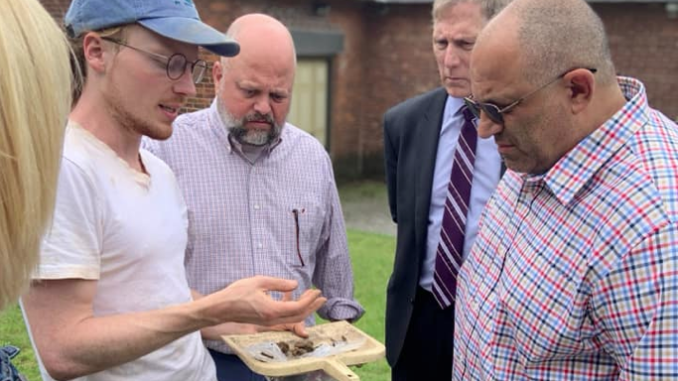
PARK RIDGE, N.J.—There was no pay dirt recently for researchers hoping to locate traces of wampum production near Electric Lake in Park Ridge.
However, at some private homes, investigations are ongoing to excavate possible sites where wampum-making may have occurred.
Archeological researchers hoping to find remnants or debris from the once prolific and widely known wampum-making production center known as Campbell’s Wampum Mill—which used Caribbean conch shells often carried as ballast in boats docking in New York waters—have come up empty, according to one of the archeologists who organized and managed a mid-June dig at the site.
After about two weeks excavating the Mill Pond area, also known as Electric Lake, where a wampum factory operated for four decades, researchers from Harvard and Montclair State universities did not find any trace of shell fragments, debris or remains from the former wampum production facility that operated there from about 1810 to 1850.
Wampum factory closed
One-hundred-seventy years ago or so the Campbell Wampum Factory closed its doors in Park Ridge’s Mill Pond area and moved its wampum production to another location along the Pascack Brook, plus scattered local home-based production sites, according to Eric Johnson, a Harvard University doctoral candidate in archeology.
Johnson has partnered with Chris Matthews, an anthropology professor at Montclair State University, to excavate the site and other related local sites.
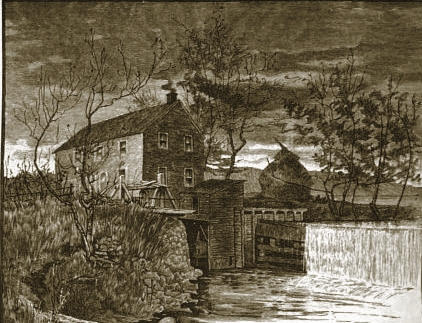
‘It was happening there’
“We know that [wampum making] was happening there but the park has gone through so much development after 1830 that we haven’t been able to locate anything,” said Johnson July 5.
“Wampum” is a Native American term for “string of beads,” according to local historians.
Johnson said Park Ridge residents have contacted him about finding fragments of conch shells on the Mill Pond site as youngsters as well as similar shells found in some residents’ backyards and gardens.
He said researchers were “triangulating” the reports of conch shell findings—such shells were used in wampum-making—to try to determine where the wampum production sites may have moved following its departure from the Van Riper Bobbin Mill in 1850.
Wampum was used by Native Americans as a powerful sacred object for making peace and declaring treaty rights, said Johnson, who noted that he is working with representatives from the Ramapough Lunaape (Lenape) Nation, to investigate other local areas of possible wampum production.
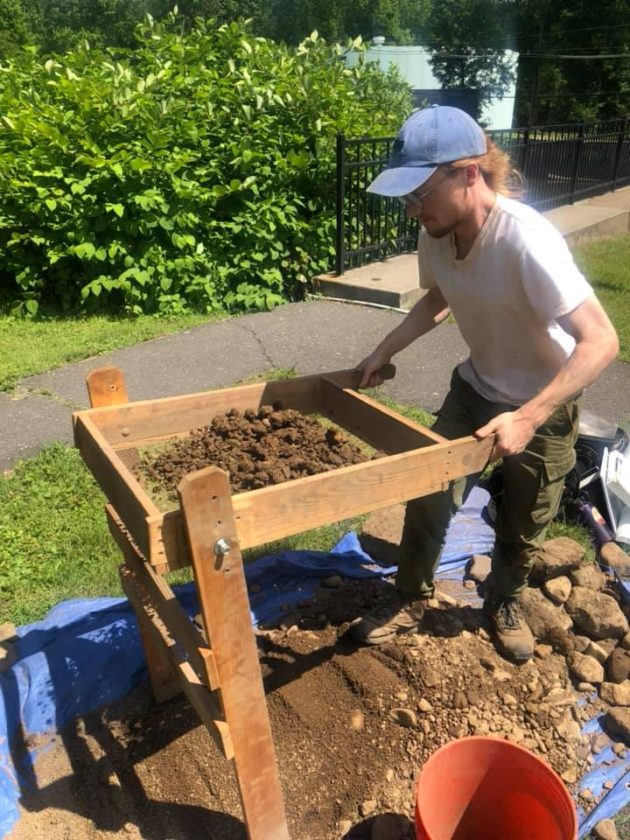
Wampum for pow-wows
Occasionally, wampum was used as currency by cash-poor European colonists, but the beads went beyond currency or fashion for Native peoples.
“Certain types of wampum, such as hair pipes, are worn at pow-wows, ceremonies and other important events,” said Johnson.
Johnson said neighbors and friends of the Campbells also took up wampum production at their homes, which likely led to wampum debris and discarded shells on private properties around the borough.
He asked any residents who have found shell fragments or Caribbean conch shells on their property and who wish to participate in a private excavation on their property to contact him.
By the mid-18th century, Euro-Americans appropriated the traditional craft of wampum-making for mass production, said Johnson.
The famous Campbell Wampum Factory exported different styles of beads such as wampum and hair pipes through the American fur trade after 1800, he added.
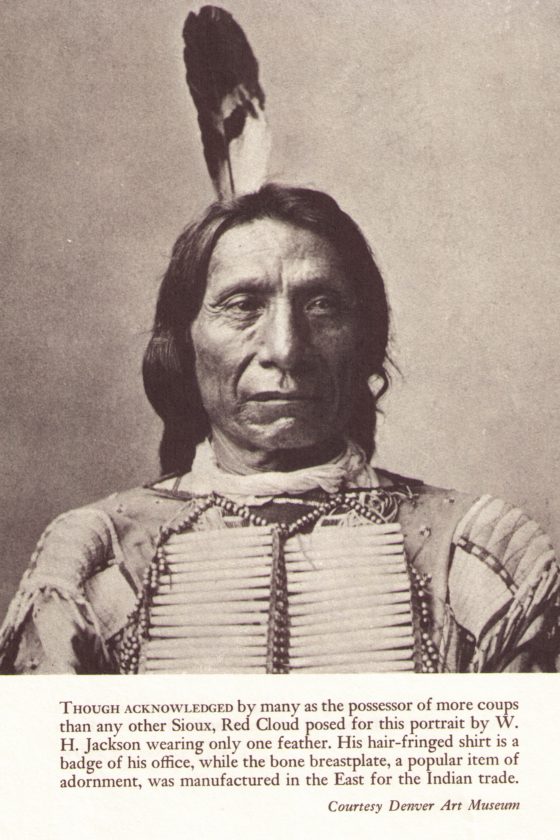
‘Studying the remains’
“By studying the remains of these bead factories [we] hope to learn how beads were made, the effects of industrialization, and how Native Americans influenced production in Park Ridge,” Johnson told Pascack Press.
Although they did not find wampum debris or fragments at the former factory site, such as shell shards, Johnson said with assistance from Chief Vincent Mann of the Ramapough Lenape Nation, a team of archeologists completed phase one, which consisted of digging “test pits” on a grid across the property.
The test pits are dug 2 feet deep by 1 foot wide on a grid across the property, explained Johnson, and archeologists screen the soil, collect artifacts, and then refill holes.
Any artifacts get bagged, cleaned, catalogued and analyzed in the lab, he added.
“As of now, the project has not recovered any remains of shell bead making at Mill Pond. Instead, we have recovered architectural debris, foundations of buildings, and trash related to the Van Riper Bobbin Factory and the many workers who lived and labored at the site in the mid-19th century,” Johnson said.
The Van Riper Factory was the largest producer of bobbins (cylindrical spools used in textile production) in the northeastern United States at the time, he said.
Back in mid-June, an excited Mayor Keith Misciagna had visited the site and urged residents to stop by and speak to Johnson to learn more about the dig.
He tagged his Facebook post “Attention all wanna be archeologists!” and his posting exclaimed: “And he already has found evidence of a possible 19th Century factory!!!”
Problems finding wampum
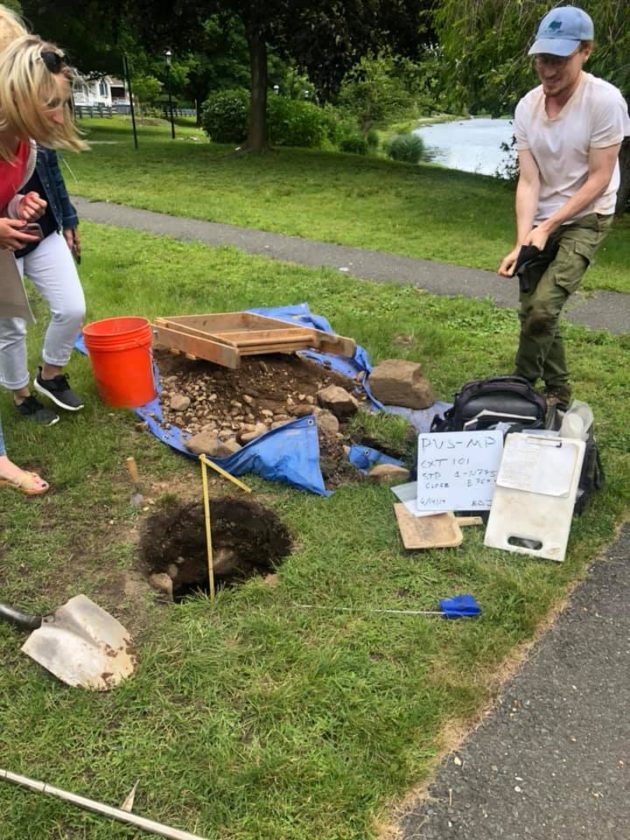
Johnson attributed the lack of success in finding artifacts to numerous possible causes: the burning and destruction of the Van Riper Bobbin Factory in 1876, in which the wampum production facility had space; and landscaping of the site in the 20th century, which likely destroyed earlier artifacts at the site or buried them too deeply, he said.
During the early to mid-1800s, wampum makers of European descent were well-documented in historical records, said Johnson.
He said the region was home to indigenous Ramapough Lenape people through the 19th century, as well as enslaved and free African Americans, who lived and labored in Park Ridge during the period.
“We are investigating the untold role these people likely played in the wampum industry,” he said.
The Campbells sold their products to New York merchants who then traded with Native Americans everywhere from the Great Lakes to the Southern Plains of Oklahoma to the Northern Plains of North Dakota,” Johnson told Pascack Press.
Investigations ongoing
“We are continuing to investigate other sites in the area. Many residents of the Pascack Valley were manufacturing shell beads in their own homes in the 19th century,” said Johnson.
“Not surprisingly, modern residents have reached out to the project, noting shells—including clam shells or Caribbean conch shells—in their backyards. We cannot comment in detail on these ongoing investigations out of respect for private landowners,” Johnson added.
He said interested residents who have found shells or shell fragments in their yards, or have questions about the excavation, should contact him at ericjohnson@g.harvard.edu or contact research partner Chris Matthews at matthewsc@montclair.edu.
The Pascack Historical Society at 19 Ridge Ave. in Park Ridge has a permanent display on the local wampum industry, including the only extant wampum hairpipe drilling machine, along with other ephemera highlighting the John W. Campbell family (of Montvale) and their important role as wampum entrepreneurs in the region.
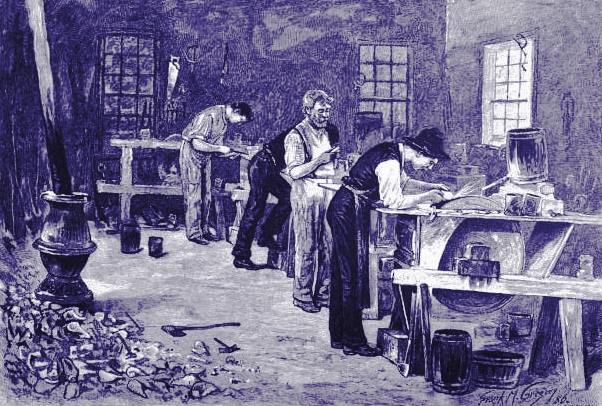
Wampum for winter
Like many families, the Campbells were farmers and made wampum during the winter months, generally October through March.
A 17-minute video explaining items from the Campbell Wampum Factory on display at the Pascack Historical Society’s John C. Storms Museum details the history of wampum-making in Park Ridge.
Items explained include the Campbell brothers’ ledger books, wampum production techniques, and details on the many uses of wampum and its popularity.
Two society trustees, Vice-President Kristin Beuscher of the Township of Washington, also Pascack Press “Back In Time” columnist, and Dr. Marilyn Miller of Park Ridge, narrate the video tour of wampum-related items.
A link to the video can be found on the historical museum’s website at pascackhistoricalsociety.org.
More from the Pascack Historical Society:
Photos: Keith Misciagna on Facebook
